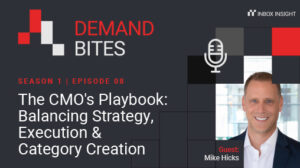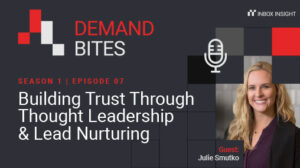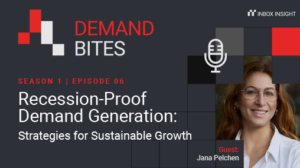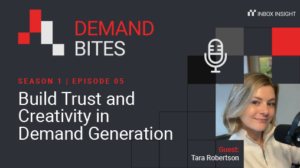The B2B buying landscape has grown increasingly complex, with 80% of purchases involving multiple different decision makers, each expecting personalized engagement at every stage of their journey. Today’s buyers also chart their own course, delaying direct conversations with sales teams until they’ve conducted extensive independent research.
Despite these changes, many organizations are still clinging to outdated tactics, focusing on lead generation rather than guiding prospects through a trust-building process. Without a data-driven engagement strategy, they risk wasting valuable resources and losing high-intent prospects to competitors delivering more seamless, buyer-centric experiences.
To succeed, businesses must embrace a dynamic, multi-touchpoint approach. Aligning marketing with the full buyer journey enables companies to nurture prospects effectively, build trust across all stakeholders, and drive long-term customer loyalty. This article explores how to build and optimize your B2B marketing funnel to drive sustainable growth.
The evolution of the B2B marketing funnel
Traditionally, buyers followed a straightforward path, from awareness to consideration, and finally to a decision. Marketing teams generated the leads and sales closed deals. However, this linear approach no longer reflects how B2B buyers engage with vendors.
Today’s B2B purchase process is more complex, involving:
- Self-directed research: A third (33%) of B2B buyers spend 3-9 hours per month researching new technologies, while 23% invest 10-19 hours.
- Multiple information sources: 42% of buyers consult 4-6 sources during research, and 35% review 7-10 before deciding.
- Large buying committees: 31% of purchases involve 4 to 8 stakeholders, while 29% involve 8 to 12 members.
Each member of the buying group will have their own pain points and priorities. This means that to remain competitive, businesses must tailor their messaging to different roles, from finance to IT. They must also provide relevant, high-value content across multiple channels to ensure their brand remains top of mind throughout the decision-making process.
With a well-defined B2B marketing funnel, businesses can ensure their marketing and sales teams work in sync, guiding prospects through each stage with the right content, engagement strategies, and touchpoints.
Beyond acquisition: The shift to long-term engagement
B2B marketing no longer ends at lead generation. As competition grows, retaining and expanding customer relationships has become just as critical as acquiring new ones. Businesses that prioritize ongoing engagement—through onboarding programs, customer communities, and referral incentives—can maximize lifetime value and turn satisfied buyers into advocates.
Anouschka Elliott, Global Head of Marketing at Goldman Sachs Asset Management, highlights this shift:
“The funnel is very, very useful to explain to non-marketers what we do. It gives them a framework they understand and can connect with. But we’re missing advocacy, we’re missing the loyalty, we’re missing that continued relationship we need to be building, and all of the complexity of the actual journey.”
To thrive, organizations must move beyond static funnels and embrace a flexible, data-driven strategy that prioritizes long-term relationships. Companies that align marketing and sales, leverage real-time engagement insights, and optimize multi-channel outreach will not only attract new customers but also retain and grow their existing base.
The progressive B2B marketing funnel: 7 key stages
The modern B2B marketing funnel is no longer a rigid, one-size-fits-all model. Instead, it has evolved into a holistic, multi-touch journey that moves prospects seamlessly from problem awareness to brand advocacy.
A well-structured funnel encompasses seven key stages:
- Problem Awareness – The prospect recognizes a pain point or challenge.
- Solution Awareness – They start researching potential solutions.
- Product Awareness – They discover your specific offerings and evaluate options.
- Conversion – They make a purchasing decision.
- Onboarding – The customer experience begins with implementation and education.
- Loyalty – The company nurtures relationships to drive satisfaction and retention.
- Advocacy – Customers become brand ambassadors, referring new business.
Each stage requires a strategic mix of paid (LinkedIn Ads, Google PPC) and organic (SEO, content marketing) strategies to generate leads and foster long-term relationships. While the timeline for moving through these stages varies, the ultimate goal is to create a frictionless experience that supports the buyer’s journey at every step.
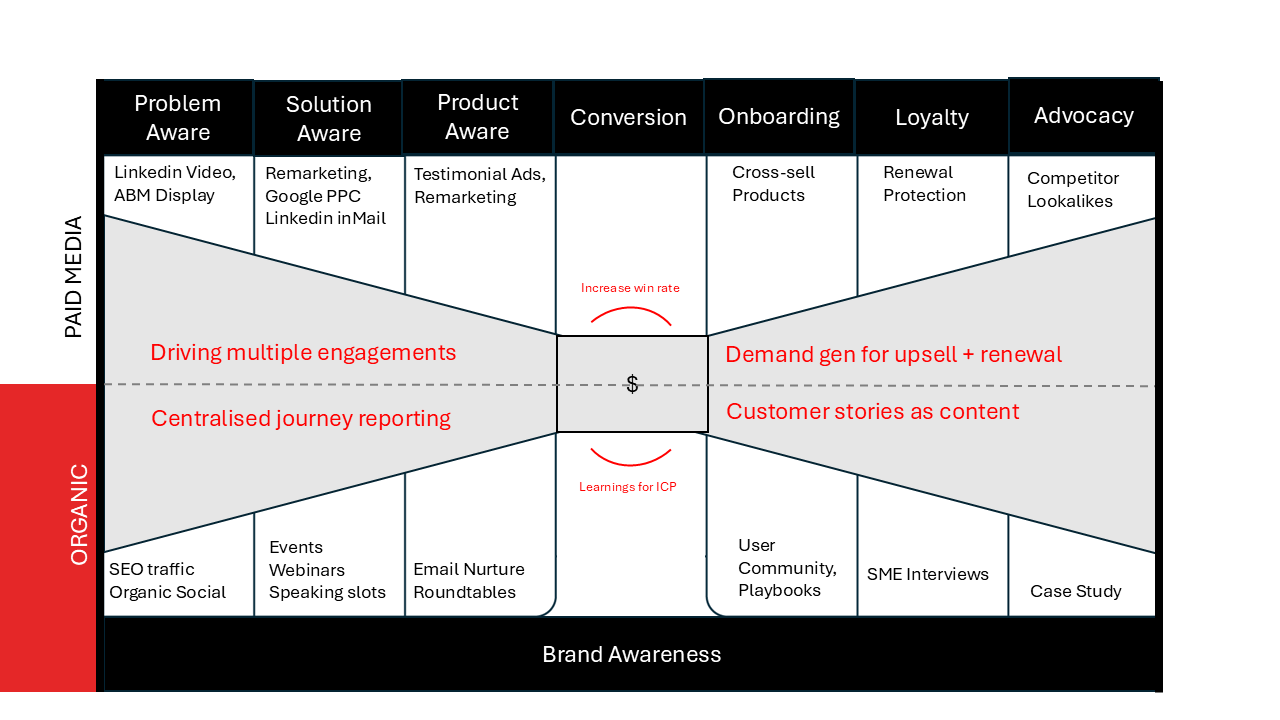
Building an effective B2B marketing funnel
As B2B buying journeys continue to evolve, marketing leaders must adapt their approach to funnel management.
Today’s successful organizations recognize that the true value of a marketing funnel lies in creating a cohesive experience that guides prospects from initial awareness through to long-term advocacy. Forging and maintain lasting relationships with customers at every stage of their journey will be key to staying competitive and driving growth.
To achieve this, marketing teams should focus on the following areas:
1. Strategy & planning: Setting up the foundation
Setting clear goals and KPIs
Begin by setting clear, measurable goals and key performance indicators (KPIs) that provide direction and allow for ongoing assessment of your demand generation efforts. These objectives should align closely with broader business goals, enabling you to track effectiveness and make informed tactical adjustments.
Defining your target audience
Understanding your ideal customer is fundamental to funnel success. Develop detailed Ideal Customer Profiles (ICPs) that go beyond basic demographics, incorporating firmographics, specific pain points, and nuanced buying behaviors. Leverage data analytics and continuous customer feedback to refine these profiles, ensuring your marketing efforts resonate with the most promising prospects.
Aligning sales and marketing
Critical to this foundation is alignment between sales and marketing teams. Establish regular communication channels, develop shared goals, and create a seamless process for lead handoff. This collaborative approach maximizes conversion potential and ensures a consistent experience for potential customers.
2. Customer journey & engagement: Building the funnel
Mapping customer journey touchpoints
Understanding how potential customers interact with your brand is key to guiding them through the funnel. Identify and map each touchpoint in the buyer’s journey to create a seamless, personalized experience. From initial engagement to conversion, ensuring a cohesive journey builds trust and credibility at every stage.
Creating high-value content
Providing valuable, research-driven content positions your brand as a trusted authority. Industry reports, case studies, and thought leadership articles tailored to different buying stages help nurture prospects and move them through the funnel. Given that 75% of decision-makers actively research and recommend solution providers, offering insights that align with their priorities—such as ROI, operational efficiency, and long-term value—can drive meaningful engagement. With 58% of decision-makers holding direct sign-off authority, crafting messaging that speaks directly to their needs is essential.
Utilizing social proof
Decision-makers rely on peer recommendations and third-party validation. Featuring client testimonials, video reviews, and case studies reinforces credibility and influences purchasing decisions. With 44% of B2B buyers placing greater trust in independent research than vendor messaging, leveraging expert endorsements and unbiased customer reviews strengthens brand authority. 75% of decision-makers also express greater trust in brands affiliated with industry experts or influencers, emphasizing the value of third-party validation.
3. Advanced strategies: Enhancing targeting & conversion
Implementing intent data and predictive analytics
Leveraging AI-driven tools to analyze prospect behavior and identify purchase intent can improve targeting. Predictive analytics helps prioritize high-value leads and personalize outreach, increasing conversion potential.
Focusing on Account-Based Marketing (ABM)
ABM allows for hyper-targeted engagement with key accounts. Customizing messaging, content, and offers for decision-makers within targeted organizations enhances relevance and effectiveness.
Leveraging retargeting and remarketing
Retargeting campaigns help keep your brand top-of-mind by displaying relevant ads to previous visitors. Email remarketing and dynamic content personalization help re-engage potential buyers and drive conversions.
4. Optimization & growth: Improving funnel efficiency
Designing multi-touch campaigns
Implementing multi-touch campaigns that leverage multiple channels, such as email marketing, webinars, social media, and retargeting, increases the likelihood of engaging and converting leads. Diversifying your approach ensures that your messaging reaches prospects through their preferred channels while maintaining a personalized experience.
Managing budget constraints
Allocating budget across multiple channels requires careful planning and prioritization. Focusing on the channels that deliver the highest ROI and adjusting allocations based on performance can help manage budget constraints while maximizing impact.
Balancing automation and personalization
While automation can enhance efficiency, it’s important to balance it with personalized interactions. Ensuring that automated processes still deliver tailored experiences helps maintain a personal connection with prospects, which is vital for building trust and driving conversions.
Tracking lead quality
Maintaining a focus on lead quality throughout the customer journey is essential. Implementing robust tracking systems and regularly assessing lead quality ensures that your efforts are directed towards prospects with the highest potential for conversion.
Implementing A/B testing
Regularly testing different campaign elements, such as email subject lines, ad creatives, or landing page designs, helps identify what works best. This data-driven approach allows you to continuously refine and optimize your funnel for better performance and higher conversion rates.
Ultimately, the businesses that embrace personalization, continuous optimization, and trust-building throughout this progressive funnel will achieve higher conversion rates, greater efficiency, and long-term success in an increasingly complex market.
Adapting your strategy for long-term success
A well-optimized marketing funnel isn’t just a competitive advantage—it’s a necessity for survival. As buyer expectations continue to shift toward personalized, multi-channel experiences, organizations must continuously refine their approach, viewing their marketing funnel not as a static framework but as a dynamic ecosystem that evolves alongside changing market conditions.
If you’re looking to accelerate your growth with full-funnel campaigns that effectively reach and convert your target audience, our B2B demand generation services can help transform your approach. Learn how we combine data-driven insights, multichannel activation, and AI lead prioritization to drive meaningful results across every stage of your marketing funnel.


